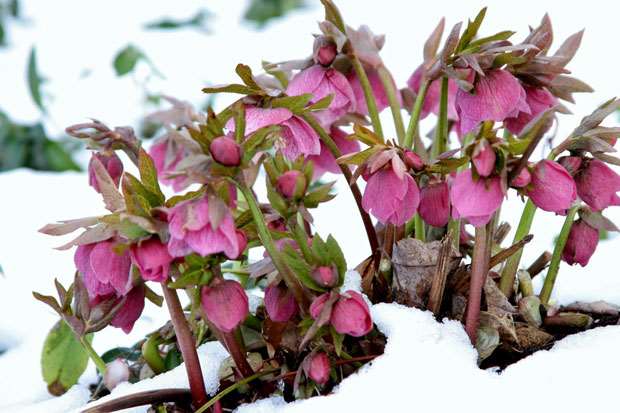The Garden in Winter
Perennials 101, Seasonal Activities through the Year
 By mid-November many of us put away the lawnmower and grudgingly bring the snow shovels out of storage. But hard core gardeners know some of the best stuff happens in winter. Here are just three ideas to keep your garden interesting even through the coldest months.
By mid-November many of us put away the lawnmower and grudgingly bring the snow shovels out of storage. But hard core gardeners know some of the best stuff happens in winter. Here are just three ideas to keep your garden interesting even through the coldest months.
1. Use Evergreen Foliage
We all know about Spruce, Cedars and Yews. These plants provide shelter and food for birds and other creatures. However, these large evergreens are too bulky to use en masse in most urban landscapes. Consider using the following evergreen perennials to add shades of green as well as other colours to the otherwise dull brown winter landscape. Some great choices are listed here but be sure to check these for hardiness in your region.
Sedum Angelina – Beautiful trailing plant with vivid yellow foliage in summer turning coppery orange in winter.
Euphorbia myrsinites – Donkey Tail Spurge has blue-silver foliage and great texture.
Sempervivum – Hens and Chicks come in a range of colours and are very easy to grow.
Vinca – Tough evergreen groundcover that even flowers in winter in the milder parts ofCanada.
Geranium cantabrigiense – Hardy evergreen groundcover, foliage turns red in colder months.
Heuchera – Plants come in a range of shades from caramel to pewter and burgundy. It does best in well drained soil.
Polystichum acrostichoides – Christmas Fern is one of the better evergreen ferns for cold climate gardening. Or try Dryopteris erythrosora (Autumn Fern).
Carex – An evergreen grasslike plant with nice variegated foliage well into winter.
Others worth considering are Ajuga, Dianthus, Iberis, Pachysandra, creeping Phlox, Sagina, Thyme, Epimedium, Hedera, Helleborus, Bergenia and many types of Campanula.
2. Use Plants With Winter Texture
Even plants that are not evergreen can be useful in the winter landscape. Ornamental grasses are justly famous for this, but there are many other great perennials for winter texture.
Miscanthus – This group of grasses is beautiful summer, fall and winter. Just remember to cut back the old shoots in spring to make room for new growth. Seed heads remain attractive through winter.
Sedum Autumn Joy – The stems and seed heads add great interest to the winter landscape, especially when they serve as scaffolding for a layer of fresh snow.
Rudbeckia and Echinacea – Their seed cones remain decorative well into winter, plus they serve as food for birds.
3. Attract Birds to your Garden
Winter is a lot less dull with active flocks of birds busying themselves in the garden. Cardinals and Finches add vivid colour to the white winter landscape. Many of the plants already discussed are attractive to birds in winter. Others include Asters and Echinops (Globe Thistle).